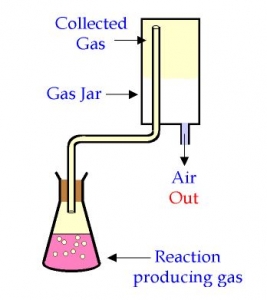A particle that contains 9 protons, 10 neutrons and 10 electrons is
positive ion
neutral atom of a metal
neutral atom of a non-metal
negative ion
Correct answer is D
protons = 9
neutrons = 10
electrons = 10
Electronic configuration = 2, 8
Ground state Electronic configuration=2, 7
It means that the atom has gained an electron thereby making it have a negative ion.
When an atom donates an electron, it becomes positively charged.
When an atom accepts an electron, it becomes negatively charged
further heating
adding concentrated H2SO4
cooling the acid solution with cold water
bubbling air through the acid solution
Correct answer is D
Bubbling of air through the acid solution removes deposited oxides of nitrogen.
Nitric acid is prepared in the laboratory by heating a nitrate salt with the concentrated acid.
NaNO3 + H2SO4 → NaHSO4 + HNO3
Vapours of nitric acid are condensed to a brown liquid in a receiver cooled under cold water. "Dissolved oxides of nitrogen" e.g NO2 are removed by redistillation or blowing a current of carbondioxide or dry air through the warm acid
The gas that can be collected by downward displacement of air is
chlorine
sulphur (IV) oxide
carbon (IV) oxide
ammonia
Correct answer is D

Upward delivery works well for hydrogen and ammonia, which are both less densed than air. Sometimes, they are collected over water.
An oxide XO2 has a vapour density of 32. What is the atomic mass of X?
20
32
14
12
Correct answer is B
Molecular mass = vapour density X2
Mm of XO2 = x + 16(2) = x + 32
vapour density = 32
∴ x + 32 = 32 × 2
x + 32 = 64
x = 64 - 32
x = 32
∴ the relative molecular mass of X is 32
Relative molecular mass = vapour density × 2
According to Charle's law, the volume of a gas becomes zero at
−100°c
−273°c
−373°c
0°c
Correct answer is B
Where −273°c = OK
i.e −273°c + 273 = OK
At zero kelvin, the volume of a gas becomes zero.
JAMB Subjects
Aptitude Tests